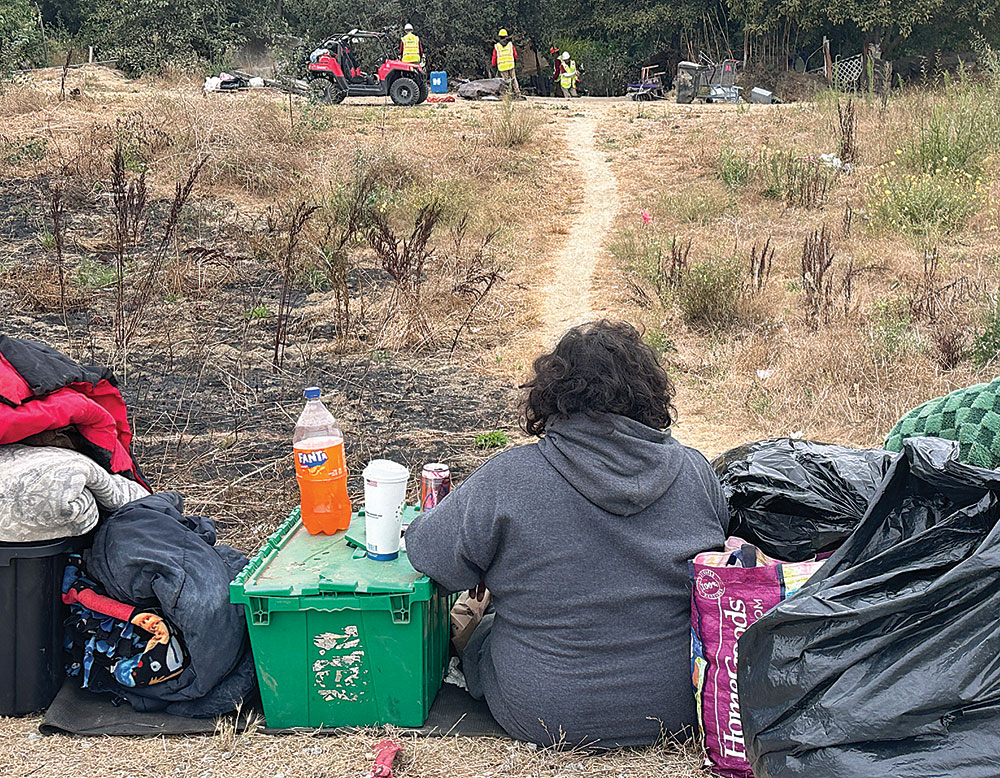On Aug. 25, Brenda Duarte was standing alongside a pile of her belongings in between the train tracks and the Pajaro River Levee. The 27-year-old wondered where she was going to sleep that night.
Surrounding her were scores of recently abandoned campsites that had peppered the levee, including tents, lean-tos, shanties and even a small platform containing a tent perched precariously in the branches of a tree.
Most of these had been abandoned in the early morning by people who were evicted—officials at the scene estimate 150 people lived in unsanctioned encampments along the levee—to make room for the upcoming Pajaro River Levee reconstruction project.
In their wake were heaps of things the residents had accumulated—tarps, tents, cooking equipment, mattresses, clothes and a profusion of trash.
“It sucks,” Duarte said. “They told us we had to leave, but they didn’t give us a place to go.”

Pajaro River Flood Management Agency Director Mark Strudley said that homeless services advocates are working to find places for the evicted people to go, including providing bus tickets so they can travel to friends or family.
Still, with few local shelter options and with all 34 spots in Recurso de Fuerza already taken, that’s no easy task.
That village of 34 tiny homes at Westview Presbyterian Church in Watsonville was created to house the people living on the levee while the work takes place.
“I think it’s universally known that there isn’t enough shelter space available for everyone out there,” Strudley said.
Strudley said that various nonprofit organizations have been giving notice about the impending eviction over the past two months, and there was a “soft notice” on Aug. 14 and 15.
Law enforcement began giving “hard notices” on Aug. 19, he said.
As workers used heavy equipment to toss it all into waiting dumpsters, groups of people stood on the fringes, few with a plan of what to do next. Some, including Juan Tejeda Isiordia, had no plans to leave.
“I have no family, no kids,” said Tejeda, 62, through a Spanish translator. “I don’t have much, and I have nowhere to go.”
Monika Tone, president of the Pajaro River Homeless Union, said that the cleanup and eviction was another blow to the homeless community that only recently had recovered from the floods that inundated the Pajaro region when the levee breached in 2023.
She said that recovering after such a sweep—including replacing tents, blankets, identification cards and medical records—is a daunting task.
“And now we have everything took again,” Tone said. “The most disrespectful thing they can do is come out here; they bring bulldozers and snatch up everything and just displace it. They’re taking away people’s shelters.”
Tone also wondered why the cleanup was happening now, with construction on that portion of the river not expected to happen for two years, and with ongoing construction of Recurso de Fuerza not expected to be complete for at least three months.
Strudley explained that the encampments endanger both the integrity of the levee and the safety of the staff and other people who must enter the levee.
This includes the shelters dug into the earth, he said.
“We can’t tolerate dugouts in the levee because it weakens it,” he said. “We can’t get people and our consultants and staff in and out of there.”
In addition, many residents and businesses have complained about vandalism and theft that occurs in the area.
“It’s not just a maintenance issue for us, it’s also a public nuisance issue,” Strudley said.
Monterey County Board of Supervisors chairman Glenn Church agreed.
“This is an effort to address the longstanding homeless problem on the Pajaro River levee,” he said in a text message. “The encampment is a threat to the stability of the levee because of digging and other activity. The Pajaro River Flood Management Agency is developing a long-term plan to prevent any further encampment so that people and infrastructure on both sides of the river are protected.”
The work is being conducted by Oakland-based Lagestic, LLC, which was awarded a $262,222 contract for the cleanup—expected to finish by Sept. 30—and $238,340 for vegetation thinning, which will be finished by Oct. 15, according to a report by flood management agency staff.













